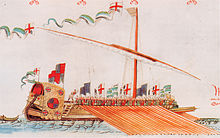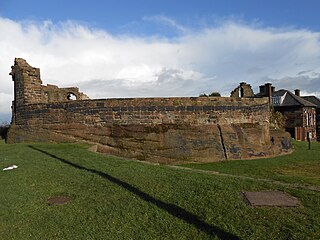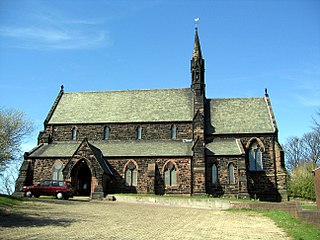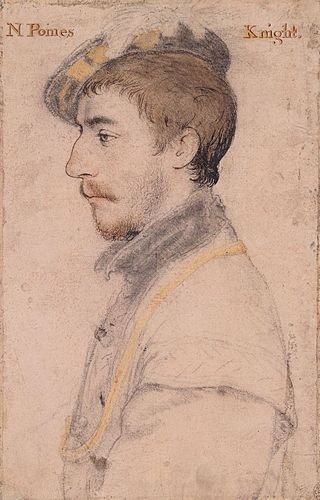Richard Brooke or Broke (died 1569) was an English landowner and navy officer.
Contents
- Early life
- Knights of Malta
- Scotland and the Galley Subtle
- Manor of Norton
- Later life
- Family
- References

Richard Brooke or Broke (died 1569) was an English landowner and navy officer.

Richard Brooke was the younger son of Thomas Brooke of Leighton in Nantwich Hundred and Elizabeth, a daughter of Hugh Starkey of Oulton. Starkey was a Gentleman Usher to Henry VIII. [2]
Brooke became a soldier and was admitted as a Knight of Malta in 1531. Hugh Starkey's son Oliver Starkey was also a Knight of Malta. Brooke became Commander of the Mount St. John Preceptory in North Yorkshire. After the suppression of the Order in England by Henry VIII circa 1542, Brooke was relieved of his religious vows and held the office of Vice-Admiral of England, a jurisdiction on the Cheshire coast. [3]
In May 1544, during the war now known as the Rough Wooing, Brooke served in Lord Hertford's army in Scotland which sacked and burnt Edinburgh. Brooke captured and destroyed the fortress on the island of Inchgarvie in the Galley Subtle on 6 May 1544. [4]
In September 1547 an English navy commanded by Lord Clinton comprising 34 warships with 26 support vessels sailed to Scotland. [5] The Galley Subtle, captained by Richard Brooke, bombarded the Scottish army at the battle of Pinkie. William Patten included the ship in one of his plans of the battlefield, depicted in the woodcut with its oars visible, close to Musselburgh. [6]

The galley was used because it could be rowed near the shore to fire its ordnance. [7] The galley crew included condemned prisoners from London jails whose sentences were commuted to sea service. [8] The guns of the ships in English fleet were recorded in an inventory. The Galley Subtle carried two brass demi-cannons, two brass Flanders demi-culverins, breech-loading iron double basses and single basses. [9] The ship was also called the Rose or Red Galley. [10]
After Pinkie, on 15 September Broke and the Galley Subtle rowed up the River Forth to Blackness Castle. After an exchange of fire he captured the Mary Willoughby , the Anthony of Newcastle and the Bosse, and burnt other ships. [11] Next, an "assured Scot" Michael Durham and the English commander Andrew Dudley sailed in the galley from Leith to Broughty Castle and fired three shots at the castle. The castle surrendered to Dudley as pre-arranged. [12]
Richard Brooke bought the manor of Norton, near Runcorn, Cheshire from Henry VIII in 1545 following the dissolution of the monasteries. [13] The manor included the former monastery of Norton Priory and the settlements of Norton, Stockham, Acton Grange and Aston Grange in Cheshire, and Cuerdley in Lancashire. [14]
Following the dissolution of the monasteries, the abbey of Norton Priory was made inhospitable. [15] Having bought the property, it seems that Brooke did not have the resources necessary to build an expensive house and therefore he modified the west range of the abbey as his residence, while the cloister became a rubbish dump. [16] The remaining buildings and the church were demolished and sold for building stone. [15]
Following the accession of Queen Mary to the throne in 1553, Brooke assisted Reginald Pole in the re-establishment of the Order of St John in England. [17] Brooke was Sheriff of Cheshire in 1563. He was succeeded at Norton Priory by his eldest son, Thomas. [14]
He married Christian, daughter of John Carew of Haccombe in Devon. The genealogy of the family is variously reported. Their children or grandchildren included. [18] [14]
After the death of Richard Brooke in 1569, his widow married Ralph Done of Flaxyards. [20]

Edward Seymour, 1st Duke of Somerset, 1st Earl of Hertford, 1st Viscount Beauchamp, also known as Edward Semel, was an English nobleman and politician who served as Lord Protector of England from 1547 to 1549 during the minority of his nephew King Edward VI. He was the eldest surviving brother of Queen Jane Seymour, the third wife of King Henry VIII.

The Battle of Pinkie, also known as the Battle of Pinkie Cleugh, took place on 10 September 1547 on the banks of the River Esk near Musselburgh, Scotland. The last pitched battle between Scotland and England before the Union of the Crowns, it was part of the conflict known as the Rough Wooing. It was a catastrophic defeat for Scotland, where it became known as "Black Saturday". A highly detailed and illustrated English account of the battle and campaign authored by an eyewitness William Patten was published in London as propaganda four months after the battle.

Inchgarvie or Inch Garvie is a small, uninhabited island in the Firth of Forth. On the rocks around the island sit four caissons that make up the foundations of the Forth Bridge.

Norton Priory is a historic site in Norton, Runcorn, Cheshire, England, comprising the remains of an abbey complex dating from the 12th to 16th centuries, and an 18th-century country house; it is now a museum. The remains are a scheduled ancient monument and are recorded in the National Heritage List for England as a designated Grade I listed building. They are considered to be the most important monastic remains in Cheshire.

The Barony of Halton, in Cheshire, England, comprised a succession of 15 barons and hereditary Constables of Chester under the overlordship of the Earl of Chester. It was not an English feudal barony granted by the king but a separate class of barony within the County Palatine of Chester.

Halton Castle is a castle in the village of Halton, part of the town of Runcorn, Cheshire, England. The castle is on the top of Halton Hill, a sandstone prominence overlooking the village. The original building, a motte-and-bailey castle began in 1071, was replaced with the current sandstone castle in the 13th century. Building alterations continued until at least 1609, when the structure is recorded as in disrepair. The castle is recorded in the National Heritage List for England as a designated Grade I listed building, and a scheduled ancient monument.

Sir Henry Brooke, 1st Baronet was an English soldier and politician.
Events from the 1540s in England.

St Mary's Church is in Halton, which was formerly a separate village, but is now part of the town of Runcorn, Cheshire, England. It is an active Anglican parish church in the diocese of Chester, the archdeaconry of Chester and the deanery of Frodsham. The church is recorded in the National Heritage List for England as a designated Grade II listed building.

All Saints' Church is the parish church of Runcorn, Cheshire, England, sited on the south bank of the River Mersey overlooking Runcorn Gap. There is a tradition that the first church on the site was founded by Ethelfleda in 915. That was replaced, probably in about 1250, by a medieval church that was altered and extended in the 14th and 15th centuries. By the 19th century the building's structure had deteriorated and become dangerous, and it was replaced by a new church, built between 1847 and 1849 to the designs of Anthony Salvin.
The Grade I listed buildings in Cheshire, excluding those in the city of Chester, total around 80. Almost half of these are churches that are contained in a separate list.

The Rough Wooing, also known as the Eight Years' War, was part of the Anglo-Scottish Wars of the 16th century. Following its break with the Catholic Church, England attacked Scotland, partly to break the Auld Alliance and prevent Scotland being used as a springboard for future invasion by France, partly to weaken Scotland, and partly to force the Scottish Parliament to confirm the existing marriage alliance between Mary, Queen of Scots, and the English heir apparent Edward, son of King Henry VIII, under the terms of the Treaty of Greenwich of July 1543. An invasion of France was also contemplated.
The timeline of Cheshire history shows significant events in the history of the English county of Cheshire.
Mary Willoughby was a ship of the English Tudor navy. She appears in the navy lists from 1532 during the reign of Henry VIII. She was named after Maria Willoughby, a lady-in-waiting and close friend of Catherine of Aragon. The ship was taken by the Scots in 1536 and was included in the Royal Scots Navy, The English recaptured her in 1547. The ship was rebuilt in 1551, increasing in size from 140 bm to 160 bm.

Sir Nicholas Poyntz was a prominent English courtier during the latter part of Henry VIII's reign. There is a portrait drawing by Hans Holbein the Younger in the Royal Collection and an oil portrait after the same artist based on the drawing in the National Portrait Gallery, London. One further portrait also exists after Holbein.

Sir Andrew Dudley, KG was an English soldier, courtier, and diplomat. A younger brother of John Dudley, 1st Duke of Northumberland, he served in Henry VIII's navy and obtained court offices under Edward VI. In 1547–1548 he acted as admiral of the fleet and participated in the War of the Rough Wooing in Scotland, where he commanded the English garrison of Broughty Castle. He was appointed captain of the fortress of Guînes in the Pale of Calais in late 1551. There he got involved in a dispute with the Lord Deputy of Calais, which ended only when both men were replaced in October 1552.
The Burning of Edinburgh in 1544 by an English army was the first major action of the war of the Rough Wooing. The Provost of Edinburgh was compelled to allow the English to sack Leith and Edinburgh, and the city was burnt on 7 May. However, the Scottish artillery within Edinburgh Castle harassed the English forces, who had neither the time nor the resources to besiege the Castle. The English fleet sailed away loaded with captured goods, and with two ships that had belonged to James V of Scotland.

The Constable of Chester was a mediaeval hereditary office held by the Barons of Halton. The functions of the Constable are unclear, possibly they related to the custody of Chester Castle, as was the main function of most mediaeval constables, but Sanders (1960) says the office-holder was constable for the entire County Palatine.

Sir Urian Brereton was a Groom of the Privy Chamber to King Henry VIII. Whilst in this role his older brother William Brereton, also a Groom of the Privy Chamber, was executed along with others for high treason and adultery with Anne Boleyn. Many historians are now of the opinion that these executions were politically motivated. Apart from William, Urian had another brother in royal service who was a royal chaplain.
Peter Meutas or Mewtas, or Mewtis, or Meautis, or Meautys was an English courtier and soldier.